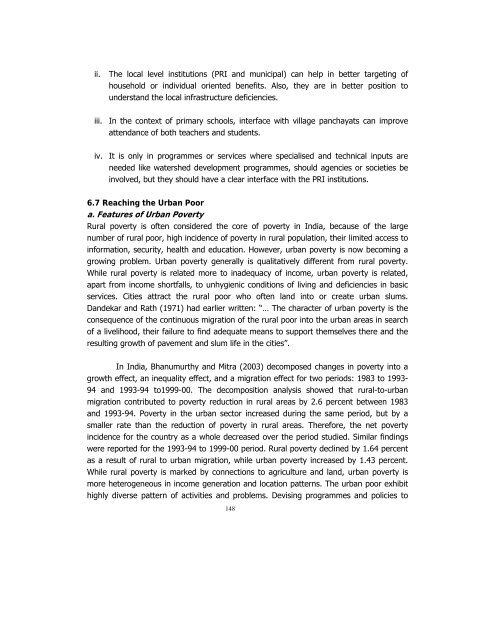POVERTY REDUCTION STRATEGY TN
You also want an ePaper? Increase the reach of your titles
YUMPU automatically turns print PDFs into web optimized ePapers that Google loves.
ii.<br />
The local level institutions (PRI and municipal) can help in better targeting of<br />
household or individual oriented benefits. Also, they are in better position to<br />
understand the local infrastructure deficiencies.<br />
iii. In the context of primary schools, interface with village panchayats can improve<br />
attendance of both teachers and students.<br />
iv. It is only in programmes or services where specialised and technical inputs are<br />
needed like watershed development programmes, should agencies or societies be<br />
involved, but they should have a clear interface with the PRI institutions.<br />
6.7 Reaching the Urban Poor<br />
a. Features of Urban Poverty<br />
Rural poverty is often considered the core of poverty in India, because of the large<br />
number of rural poor, high incidence of poverty in rural population, their limited access to<br />
information, security, health and education. However, urban poverty is now becoming a<br />
growing problem. Urban poverty generally is qualitatively different from rural poverty.<br />
While rural poverty is related more to inadequacy of income, urban poverty is related,<br />
apart from income shortfalls, to unhygienic conditions of living and deficiencies in basic<br />
services. Cities attract the rural poor who often land into or create urban slums.<br />
Dandekar and Rath (1971) had earlier written: “… The character of urban poverty is the<br />
consequence of the continuous migration of the rural poor into the urban areas in search<br />
of a livelihood, their failure to find adequate means to support themselves there and the<br />
resulting growth of pavement and slum life in the cities”.<br />
In India, Bhanumurthy and Mitra (2003) decomposed changes in poverty into a<br />
growth effect, an inequality effect, and a migration effect for two periods: 1983 to 1993-<br />
94 and 1993-94 to1999-00. The decomposition analysis showed that rural-to-urban<br />
migration contributed to poverty reduction in rural areas by 2.6 percent between 1983<br />
and 1993-94. Poverty in the urban sector increased during the same period, but by a<br />
smaller rate than the reduction of poverty in rural areas. Therefore, the net poverty<br />
incidence for the country as a whole decreased over the period studied. Similar findings<br />
were reported for the 1993-94 to 1999-00 period. Rural poverty declined by 1.64 percent<br />
as a result of rural to urban migration, while urban poverty increased by 1.43 percent.<br />
While rural poverty is marked by connections to agriculture and land, urban poverty is<br />
more heterogeneous in income generation and location patterns. The urban poor exhibit<br />
highly diverse pattern of activities and problems. Devising programmes and policies to<br />
148

















